ReactOS 0.4.10 - now with the taste of BTRFS and funny icons for folders
Hi, Habr!
Only five months have passed since the last ReactOS release , and we are already rolling out a new one! And which! As usual, we have for you a proprietary cocktail of killer features and hellish tuning of minor system components.
In this issue is the introduction of BTRFS, another additional portion of stability and a bunch of cool whistles that make using the operating system more enjoyable, unless of course it already falls into the BSOD.
')
Download installation images | Press release | List of changes | TL; DR | Tests and regression list

Photo honestly stolen from user photo album flickr.com
The main novelty of ReactOS version 0.4.10 is the full implementation of support for the BTRFS file system! In fact, minimal support for Btrfs was added last year based on the free WinBtrfs driver, but now, within the GSOC 2018 , the installer and loader codes of the Freeloader have been modified to provide access to the contents of the Btrfs partitions during startup or installation.
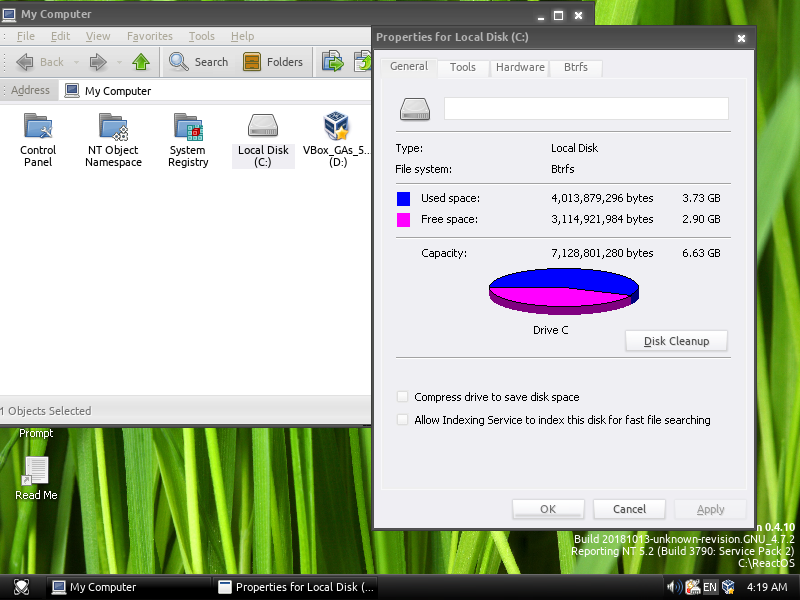
During the development process of ReactOS 0.4.10, fixes were made to the WinBtrfs driver and sent to upstream (back to the main driver developer). Therefore, in the next OS version at number 0.4.11, we will be waiting for further improvements in this direction. BTRFS support allows you to bypass the restrictions on the size and number of files on the disk that FAT file systems impose. WinBtrfs was chosen because it turned out to be the most stable and timely updated driver among all existing alternative file system options for the Windows NT platform.
I recall that ReactOS also fully supports file systems FAT12 / 16/32, Ext2, Ext3, Ext4, NFS, and a few more with read-only access - NTFS, ReiserFS, FFS and UDFS.
System stability is usually difficult to quantify, since it is often very subjective. The argument with which you are likely to agree is that everything that prevents the collapse of the operating system itself or the application running in it will go into the stability column as an additional advantage. Therefore, although the improvements in the memory management stack ( see the complete list of changes ) made by Timo Kreutzer and Pierre Schweitzer may seem insignificant or not obvious, they still play an important role in increasing the stability of ReactOS.
At the same time, the moment when a useful and popular application reaches full performance on ReactOS also represents a small victory. Stanislav Motylkova ’s contribution to the ReactOS C Runtime library allowed the Git version control system used in our project to finally work correctly and directly in the ReactOS. Probably, and here you will not argue that this is a good continuation of past success with the achievement of the state of self-hosting .
And I’m sure that no one here is a true BSOD fan, even if they evoke some sense of nostalgia. Blue screens are better to remain something of our memories than to be a constant part of the daily user experience. Fortunately for ReactOS, Mark Jensen managed to eliminate the cause of yet another such crash, concerning the work of the library of the font engine FreeType.
And if we continue the conversation about small victories, then it is worth mentioning that Mark seriously podshamanil the code responsible for parsing manifests of executable files and libraries during their initialization. As a result, the correct launch of the popular multi-protocol messenger Miranda IM has become possible.

The contribution of Thomas Faber, who figured out the problem of high CPU load while watching the video player VLC, running the DosBox 0.74 emulator and playing Anno1602 and Diablo II, also deserves special mention.
And this is something that is better to see once than 10 times to read about it. When someone uses the ReactOS operating system, the interface for this interaction is usually the desktop Explorer shell. Underlying the shell functionality is based on the shell32 library, whose improvements are often the most noticeable to end users. Over the past few months, Katayama Hirofumi, a long-time contributor to the project, has added several new functions to this library, “combing” some other functions that already existed before.
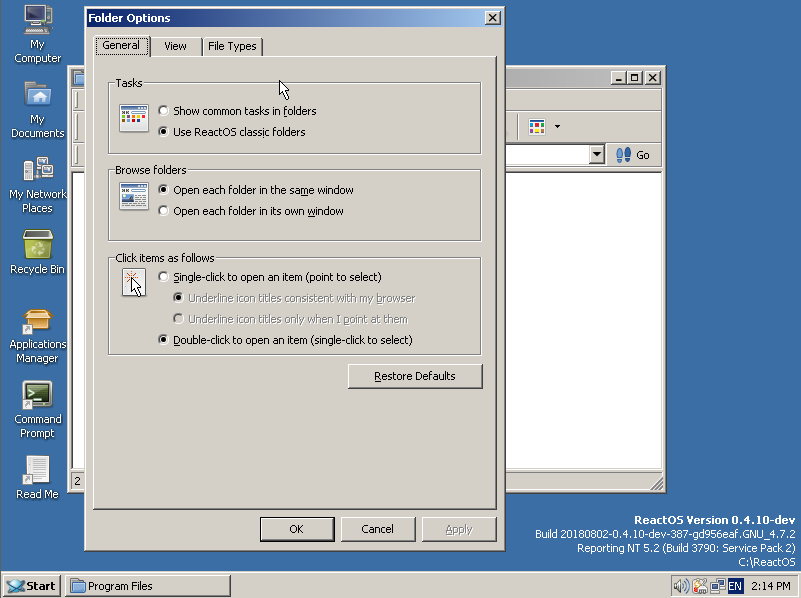
Previously, folder interactions were severely limited. Now, in the file manager, there are options for setting up the display of directories, opening a directory in a new or current window, setting up operations with a single or double click.
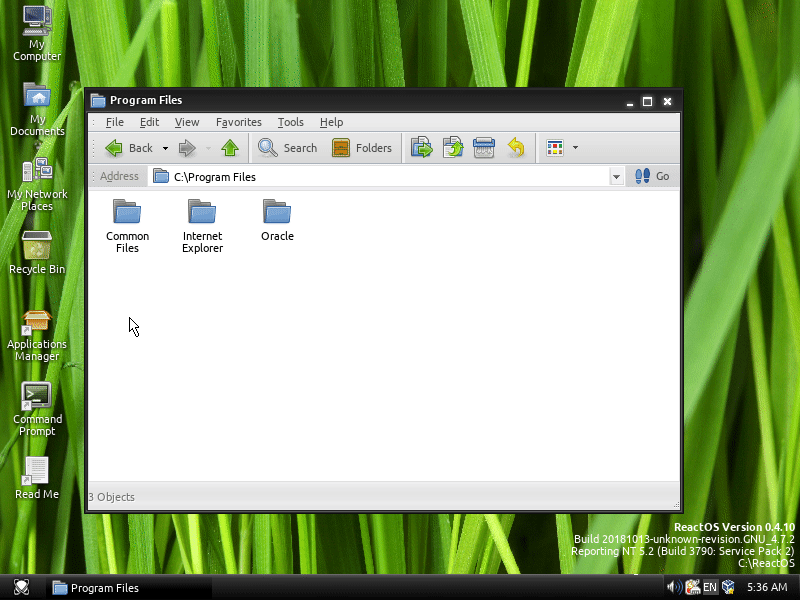
And icons for folders can be assigned at your discretion, making the folder structure less boring.
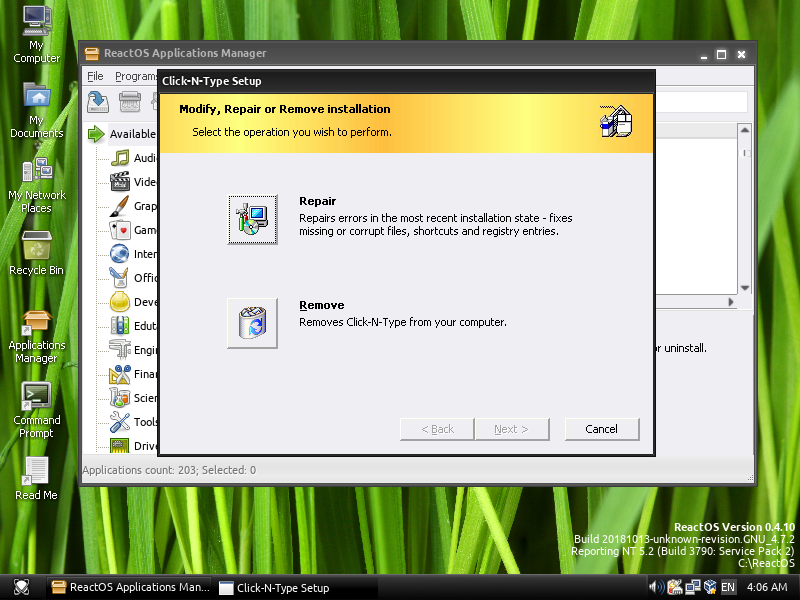
Serious work was done on the correct display of fonts and graphic elements in the dialogs of MSI installers of various programs.
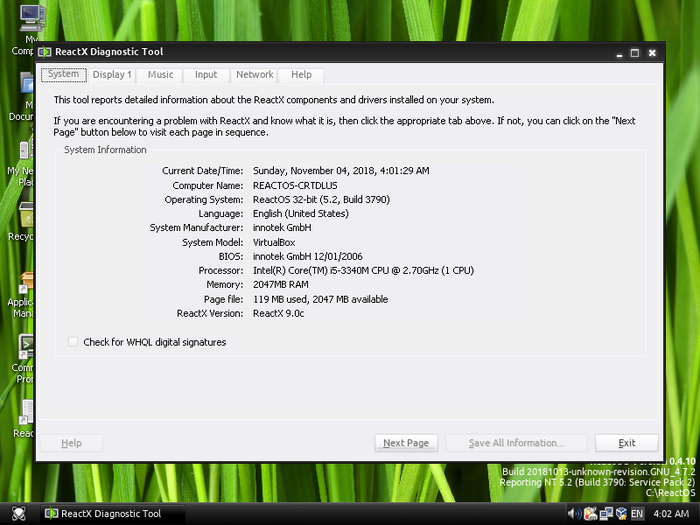
Stanislav Motylkov has also added code to correctly extract system information from the BIOS, which is now used in the output of the dxdiag utility.
This, of course, is not all, but only the most noticeable and significant changes in ReactOS. Want to see some more? Then watch the video with the demonstration of new products, which was prepared by the project volunteers:
Wanted to put ReactOS for the first time in your life? Be sure to review this manual .
Did you like this release? We are waiting for your comments and opinions! Do not forget that you can help the project not only with donations , but also simply by giving it an asterisk on the githaba !
UPD on November 21, 2018 - Vadim Galyant published a modified version of the distribution with an experimental USB stack
PS 0.4.11 release preparation is already well underway, and this release will really be worth the wait!
Only five months have passed since the last ReactOS release , and we are already rolling out a new one! And which! As usual, we have for you a proprietary cocktail of killer features and hellish tuning of minor system components.
In this issue is the introduction of BTRFS, another additional portion of stability and a bunch of cool whistles that make using the operating system more enjoyable, unless of course it already falls into the BSOD.
')
Download installation images | Press release | List of changes | TL; DR | Tests and regression list

Photo honestly stolen from user photo album flickr.com
Btrfs
The main novelty of ReactOS version 0.4.10 is the full implementation of support for the BTRFS file system! In fact, minimal support for Btrfs was added last year based on the free WinBtrfs driver, but now, within the GSOC 2018 , the installer and loader codes of the Freeloader have been modified to provide access to the contents of the Btrfs partitions during startup or installation.

During the development process of ReactOS 0.4.10, fixes were made to the WinBtrfs driver and sent to upstream (back to the main driver developer). Therefore, in the next OS version at number 0.4.11, we will be waiting for further improvements in this direction. BTRFS support allows you to bypass the restrictions on the size and number of files on the disk that FAT file systems impose. WinBtrfs was chosen because it turned out to be the most stable and timely updated driver among all existing alternative file system options for the Windows NT platform.
I recall that ReactOS also fully supports file systems FAT12 / 16/32, Ext2, Ext3, Ext4, NFS, and a few more with read-only access - NTFS, ReiserFS, FFS and UDFS.
C - Stability
System stability is usually difficult to quantify, since it is often very subjective. The argument with which you are likely to agree is that everything that prevents the collapse of the operating system itself or the application running in it will go into the stability column as an additional advantage. Therefore, although the improvements in the memory management stack ( see the complete list of changes ) made by Timo Kreutzer and Pierre Schweitzer may seem insignificant or not obvious, they still play an important role in increasing the stability of ReactOS.
At the same time, the moment when a useful and popular application reaches full performance on ReactOS also represents a small victory. Stanislav Motylkova ’s contribution to the ReactOS C Runtime library allowed the Git version control system used in our project to finally work correctly and directly in the ReactOS. Probably, and here you will not argue that this is a good continuation of past success with the achievement of the state of self-hosting .
And I’m sure that no one here is a true BSOD fan, even if they evoke some sense of nostalgia. Blue screens are better to remain something of our memories than to be a constant part of the daily user experience. Fortunately for ReactOS, Mark Jensen managed to eliminate the cause of yet another such crash, concerning the work of the library of the font engine FreeType.
And if we continue the conversation about small victories, then it is worth mentioning that Mark seriously podshamanil the code responsible for parsing manifests of executable files and libraries during their initialization. As a result, the correct launch of the popular multi-protocol messenger Miranda IM has become possible.

The contribution of Thomas Faber, who figured out the problem of high CPU load while watching the video player VLC, running the DosBox 0.74 emulator and playing Anno1602 and Diablo II, also deserves special mention.
A pinch of beauty here, a pinch of beauty there ...
And this is something that is better to see once than 10 times to read about it. When someone uses the ReactOS operating system, the interface for this interaction is usually the desktop Explorer shell. Underlying the shell functionality is based on the shell32 library, whose improvements are often the most noticeable to end users. Over the past few months, Katayama Hirofumi, a long-time contributor to the project, has added several new functions to this library, “combing” some other functions that already existed before.

Previously, folder interactions were severely limited. Now, in the file manager, there are options for setting up the display of directories, opening a directory in a new or current window, setting up operations with a single or double click.

And icons for folders can be assigned at your discretion, making the folder structure less boring.

Serious work was done on the correct display of fonts and graphic elements in the dialogs of MSI installers of various programs.

Stanislav Motylkov has also added code to correctly extract system information from the BIOS, which is now used in the output of the dxdiag utility.
And it's all?
This, of course, is not all, but only the most noticeable and significant changes in ReactOS. Want to see some more? Then watch the video with the demonstration of new products, which was prepared by the project volunteers:
Wanted to put ReactOS for the first time in your life? Be sure to review this manual .
Did you like this release? We are waiting for your comments and opinions! Do not forget that you can help the project not only with donations , but also simply by giving it an asterisk on the githaba !
UPD on November 21, 2018 - Vadim Galyant published a modified version of the distribution with an experimental USB stack
PS 0.4.11 release preparation is already well underway, and this release will really be worth the wait!
Source: https://habr.com/ru/post/430332/
All Articles